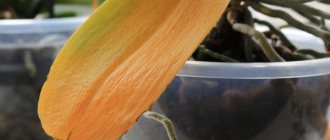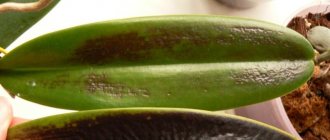Never throw away orchids, even if they no longer show signs of life! These plants are real fighters, they have so much vitality that you just need to help them a little, and they will again delight you with elegant flowers.
I practically pulled my first intensive care unit out of the trash where my neighbor was taking it. When a year later this beauty threw out a powerful peduncle, the neighbor’s surprise knew no bounds, and I was bursting with pride! I did it, I saved it! Want to know how?
How to understand that an orchid is dying?
If the plant begins to show signs of drying out, rotting roots, wilting leaves, etc., this may be either a natural process or a consequence of improper actions by the grower.
Signs of need for resuscitation
To prevent the orchid from completely dying, it is necessary to take immediate action if there are even the slightest signs that the plant needs help. You should pay attention to such manifestations as:
- the leaves on the flower not only turn yellow, but also wither;
- flower stalks dry out prematurely;
- Not only leaves and flowers fall from the stem, but even buds;
- the foliage becomes dull, glossy shine and turgor (elasticity) are lost;
- the root system fades and “wrinkles” form on it;
- the trunk of the flower takes on an unnatural dark shade;
- the roots have become gray or gray-green.
rotten roots turn yellow and wither leaves rot and wither roots
An orchid's root system should be silver or silver-green, and after watering it becomes a rich green color. Withering of the flower and flower stalk can be a natural process, but only when the indoor plant has finished its flowering period.
Time frame for orchid revival and actions after resuscitation
The recovery period for a plant can last from a month to a year, even if everything is done correctly.
The best time to resuscitate a flower is spring or autumn. In winter, the chances of salvation are much less.
When the external characteristics of the orchid improve, when the leaves turn green and new aerial roots begin to grow, fertilization is stopped and watering is reduced.
Compliance with the rules of care is not a very labor-intensive process, especially if it is an unpretentious Phalaenopsis orchid; you just need to monitor the plant more closely in order to take corrective actions in time.
Why an orchid dies: main reasons
The main signs that indicate the presence of any diseases in an orchid can appear on the foliage and root system. For example, if the leaves show signs of yellowing or they begin to curl, wither and even fall off, this may mean that the flower was not properly cared for. If the roots darken or become black, this indicates that the indoor plant has signs of a disease that arose due to a development process that is uncharacteristic for it.
Improper watering
It is recommended to water the orchid in winter no more than 1-2 times a week , and in summer it is necessary to moisten the soil in the pot 2-3 times in 7 days . If the summer days are very hot, you can increase the amount of watering.
Irrigation should not be done from a watering can, as the water may be unevenly distributed in the flower pot. Therefore, it is recommended to place the flowerpot in a container with warm water for 10-25 minutes, and then pull it out and allow excess water to drain.
Dry indoor air
In the tropics there is quite humid air, orchids feel comfortable. 60-80% is considered favorable for a flower . If the indicators are below 40%, the plant will begin to replenish the lack of moisture from all its parts, from foliage, roots and even from flowers and peduncles. You can provide the necessary humidity by installing a humidifier in the room or periodically using a steam humidifier.
Drying roots and leaves
When the orchids begin to show signs of drying out roots and foliage, the cause may be improper watering. An unhealthy state of the root system also indicates a lack of nutrients in the soil.
Root damage
The unnatural appearance of the roots should alert the grower and push him to solve the problem. Drying of one of the main organs of the plant can be caused by:
- damage to roots during transplantation;
- insect pests appeared on the roots;
- the roots show signs of being damaged by a fungal disease.
It is important to try to preserve those roots that look healthy, and thereby revive the orchid, if possible.
High room temperature
Comfortable conditions for growing orchids indoors are considered to be high air humidity and temperatures within +16-+28 degrees. If the room is hot, the plant will begin to wither or may even dry out.
It is recommended not to place orchids on the windowsill in direct sunlight in the summer. In winter, it is strictly forbidden to place the flowerpot near heating appliances.
Pests and diseases
What to do if the orchid has dried up: if signs of disease are detected on the plant, it must be immediately isolated from other flowers so that they do not become infected. Next, you need to find out what kind of disease and type of insects that caused the unhealthy appearance of the orchid. It is necessary to inspect the root system. As a result of stagnant water in the flowerpot, root rot may appear, and if appropriate measures are not taken in a timely manner, the plant will completely die.
Poor quality soil
Orchids need a special substrate, which consists of stones, tree bark, twigs and peat. During irrigation, the soil gradually becomes compacted and can deteriorate if irrigation is carried out incorrectly. As a result, the soil becomes less breathable, and due to its deterioration, insufficient nutrients may reach the roots. To prevent the death of the plant, the substrate should be updated.
Incorrect feeding
As for orchids, they are very scrupulous about fertilizers. An excess of fertilizers can cause the death of a flower, and a lack of fertilizers often provokes chlorosis of the leaves. This applies to situations where quite a lot of potassium and phosphorus were added. Their excessive use can cause disruption of the absorption of zinc and other essential microelements.
The best option is to use a complex fertilizer, so the flower can receive all the required nutrients.
Each manufacturer of fertilizers for indoor plants indicates on the packaging instructions for their use. It also indicates the dosage. But in the case of orchids, it is recommended to reduce the indicated doses by half for adult seedlings, and by 4 times for young bushes and children.
Improper care
Newcomers are usually afraid of making the wrong move, which will lead to the death of the culture.
But don’t be afraid, in fact, care is not very difficult. The main thing is to follow the recommendations and not touch the pot with a flowering plant unless absolutely necessary. Phalaenopsis really does not like familiarity and frequent moving from one windowsill to another.
There are several reasons for this phenomenon; if it is not possible to immediately determine the source, then you will have to use the method of elimination, scrupulously checking all points of care, paying attention to changes in the condition of the flower
Temperature
It is very important for supporting long-term flowering or stimulating the flower to form a peduncle. Comfortable heat level is kept between 22-26 °C. If the flower is healthy, but does not even think about blooming, it is transferred to a cooler place with a temperature no higher than 16-18 and kept for at least 2 weeks.
Such a shock drop will lead to activation of processes in the roots, and watering with a solution of succinic acid stimulates growth and the beginning of flowering.
Lighting
The health of the orchid largely depends on its level.
- It quickly reacts to the lack of sunlight by shedding the bulk of its leaves.
- A direct stream of light will cause burns to the leaf plate. The leaf will die or be sick for a long time.
The best option is to place the flower on a south-facing window with the glass covered.
Diffusing tulle or blinds are often used. If there is insufficient lighting, you will have to install phytolamps. Their choice is quite wide, while achieving an interesting decorative effect that decorates the room.
Dry air
Monitor air humidity
The orchid feels good at a humidity level of 60-70%, which is unacceptable for residents of an apartment or private house. In greenhouses, automatic microclimate maintenance systems are installed; at home, you will have to be content with daily spraying from a spray bottle with warm, settled water.
The flower loves the shower, but then it needs to be left in the bathroom until the leaves dry naturally. Microscopic droplets on the plates cause sunburn.
When the air is too dry, the orchid sheds its leaves to reduce moisture loss; when indicators acceptable for it are restored, new leaves begin to form.
Watering
All types of orchids are epiphytes, receiving water not from the soil, but from the environment. Therefore, watering in the usual sense of the word is not carried out for them. Overmoistening of the roots leads to their rotting, and contact with a leaf rosette provokes the shedding of buds and yellowing of the leaves.
To avoid negative consequences, it is worth adopting a very convenient method. When the earthen ball dries out, the pot is simply placed in a pan of water for several hours. Through the holes in the bottom, the flower itself will take as much as it needs.
Fertilizers
For feeding, complex liquid or granular preparations for cacti and orchids are used. Agricola and Good Power have proven themselves very well.
It is worth focusing on the following features:
in spring, attention is paid to nitrogen as part of complex fertilizing; in summer, the frequency of fertilizing is 2 times a month; when the first bud appears, root feeding is stopped completely; during flowering, only foliar support is carried out by spraying on the leaves; During the dormant period, fertilizers are not applied.
How to revive an orchid at home?
To bring the epiphyte back to life, it is necessary to carry out a series of resuscitation measures. It is important to adhere to the points that are presented below in the article.
Assessing the condition of the orchid
Before you begin resuscitation measures, you need to assess the condition of the flower and determine what caused its painful appearance. It is also recommended to analyze the conditions under which the flower is kept. For example, whether watering was carried out correctly, air temperature and humidity, and the degree of lighting were observed.
Rules for restoring an orchid
How to revive an orchid at home, a step-by-step guide presented in the form of rules. Once the reasons have been determined, restoration of the plant can begin. It is important to remember some nuances that will help achieve the desired result. The main ones are:
- You cannot immediately transplant a flower if it was in the sun, even if the light was diffused. You should place the pot with the plant in the shade for a while.
- When removing an orchid from the container where it grew, you need to hold it by the base. To pull out the seedling, you need to shake it slightly. If the root system is strongly strengthened in the flowerpot, you can place it in warm water for 30 minutes.
- Watering should be done carefully so that water does not fall on the inflorescences and leaf axils. This will reduce the risk of rotting of the stem and leaves. If moisture gets in, you must definitely remove it, for example, by blotting it with a napkin or placing the flower on the windowsill, but the sunlight should be diffused.
It is necessary to remove rotten parts of roots and foliage, and the cut site must be disinfected. You can make powder from activated carbon by first grinding it into powder.
Tools and materials
To carry out resuscitation measures, it is necessary to prepare appropriate tools and materials. In this case you will need:
- scissors or pruning shears (they must be sharp);
- solution required to disinfect instruments;
- hydrogen peroxide (3%);
- succinic acid;
- activated carbon in powder form;
- fungicides, for example, you can use “Fitosporin” or “Fundazol”.
Additionally, it is recommended to use a vitalizer, which is not only a growth stimulator, but also increases stress resistance in plants.
Inspection and treatment of roots
Before taking appropriate measures to save the flower, you should first carefully examine the root system. Next, you need to remove dead and damaged roots. Cut and clean to a healthy area, and then treat it with peroxide or sprinkle with powdered activated carbon.
The next stage consists of such actions. It is necessary to place the reanimated orchid in warm water (up to 35 degrees), adding vitalizer HB-101 (4 drops per 1 liter of water). Soaking time should be no more than 1 hour. After 60 minutes, the plant needs to be pulled out and allowed to dry for about 20-30 minutes. Then it is recommended to inspect the flower again; the living dry roots, which were light silver before the soaking procedure, will become dark green.
Stem problems
In a situation where traces of disease or damage by insect pests begin to appear on the stem, it is necessary to begin treating it. The presence of yellow or black spots on the flower trunk is also considered a cause for concern. Often such manifestations occur as a result of improper watering. The fact is that when irrigating, you need to avoid getting water into the leaf sinuses. The presence of liquid in them will lead to a rotting process, which can affect not only the growing points, but the entire stem. Therefore, damaged areas on the trunk should be removed and treated with “Fundazol” or “Fitosporin”
The leaves of the orchid are drying, what should I do?
When there are dried leaves on a flower, they must be removed, as they will drain life-giving moisture and nutrients from the plant. When removing, you need to take the leaf blade and tear it along the central vein. The torn leaf must be carefully removed (cut) from the trunk so as not to damage the aerial roots. Be sure to treat the cut area with cinnamon or activated carbon powder.
Transfer
One of the options for reviving a dried orchid is to transplant it into a new substrate. You can also use the old soil in which the plant grew, but it must be disinfected. For example, you can spill the substrate with a solution of potassium permanganate or plain boiled water (hot). It should be noted the nuances that must be observed when replanting a reanimated seedling. The main ones are:
- The substrate must be breathable and contain coarse pieces of coal and wood bark. Moss and coconut chips are not recommended for use at this stage.
- It is better to choose a flower pot from a transparent material, and it should also have a large number of holes that will ensure air circulation.
- The landing process is quite simple. First, you need to place expanded clay and large pieces of bark on the bottom of the container. The orchid should be carefully placed on them, and then the existing voids in the flowerpot should be filled with substrate.
If, after planting in a flower pot, the plant wobbles, then support sticks can be installed for fastening.
Watering and fertilizing
A weakened plant, after resuscitation and transplantation, must be watered with extreme caution. After all, a small number of roots are not able to fully absorb moisture. It is recommended to water using a shallow container, which should be placed under the flowerpot with flowers. Water needs to be poured into the stand, and added as it evaporates. It is better to use slightly warm, settled liquid.
As for fertilizing, in this case the best option is to use a fortified cocktail. It should contain the following components:
- B vitamins – 1 ampoule;
- sugar – 1 teaspoon;
- succinic acid – 1 tablet.
The indicated substances must be dissolved in 1 liter of water. It should not be used for watering, but for spraying. You should also wipe the leaf plates of the flower with the solution. After a month, you can feed the seedling with iron chelate.
Important! It is prohibited to use root-forming preparations to restore a plant if it has few roots or only a few leaves.
Resuscitation using a greenhouse
One of the best ways to revive an orchid at home is to create a mini-greenhouse for the plant. An analogue could be a small greenhouse. The designated structures provide the opportunity to provide the necessary conditions for flower restoration. This method must be used in compliance with certain rules. The main ones are:
- In order for the plant, namely the roots and leaves, to fully participate in photosynthesis, the greenhouse should be made as transparent as possible.
- The substrate or its component cannot be watered during the process of restoring the orchid; it can only be sprayed with water, and the irrigation procedure must be performed only around the edges.
- The location of the greenhouse or greenhouse should be well lit, but at the same time not exposed to direct sunlight.
- It is recommended to ventilate the greenhouse structure once every 2 days, for about 1 hour.
Additionally, it is necessary to wipe the leaves of the reanimated plant (if any) with succinic acid. This is a kind of feeding that will help replenish nutrients.
Restoration with sphagnum
The use of moss is also considered a good option, but in this case it is important that the sphagnum be of good quality. It must have the following properties:
- breathability;
- ability to absorb excess moisture;
- be bactericidal.
Sphagnum can be used to restore plants not only in greenhouses; it is often used in such cases without being placed in greenhouse structures.
In hydrogel
It is worth saying that hydrogel can be used only in extreme cases. This is due to the fact that the designated material maintains constant moisture, and the plant that has been reanimated is already weak. Constant humidity can lead to rotting of the salvaged flower. In this case, you need to combine the hydrogel with a growth stimulator and the plant must be periodically removed from the solution to dry. For the orchid to fully recover, the procedure of immersion in and removal from the hydrogel may take about 6 months.
In polystyrene foam
Orchids do not need tree bark or polystyrene foam added to the flowerpot. The components marked are for stability purposes only. The main nutrition of the flower is provided by photosynthesis, which occurs in the leaves and root system. The foam used to resuscitate the plant is nothing more than ballast, which will prevent the cutting or seedling from being completely immersed in water.
In aquarium
You can also use a regular aquarium as a greenhouse. It provides the opportunity to create similar conditions. This is maintaining appropriate temperature and humidity. In this case, you need to place the reanimated flower in an aquarium, cover it, for example, with film or transparent glass. This type of greenhouse should be ventilated 2-3 times a week.
Recovery with a hot shower
Very hot water can not only burn the plant, but also lead to its death. Therefore, using a hot shower, especially for a weakened plant, is quite risky. If other methods to revive the flower did not give the desired result, then as a last resort you can try a hot shower. This procedure must be carried out not only carefully, but also by following certain rules. To do this, you will need to initially water the epiphyte from above with water at room temperature, and after 15-20 minutes with water that does not exceed 45 degrees. It is not recommended to carry out water activities more than once every 2 weeks.
Preventive measures
Having studied the possible causes of leaf loss, it is necessary to develop a system of preventive measures that will help avoid mistakes in orchid care and prevent the occurrence of undesirable phenomena.
Prevention measures should include correct temperature conditions, sufficient lighting, optimal watering and fertilizing , as well as measures to identify diseases and pests. The entire complex of methods is developed in relation to each type of “daughters of the air” individually.
If you have previously made mistakes when breeding orchids, you should try not to repeat them again.
Ways to save an orchid in different situations
Depending on the condition of the epiphyte and the circumstances why the seedling withered, you can choose the methods of revival presented below.
The orchid has dropped all its leaves, but the roots are green
It is not uncommon for an orchid to bare its stem, but the root system looks healthy. Loss of all foliage may indicate problems with the flower that need to be addressed immediately. There is a possibility that the flower does not have enough light, so photosynthesis does not occur fully. Lack of moisture or its excess can also lead to leaf fall. The main thing is to eliminate the cause of the problem and the orchid will begin to recover.
Drying roots
When there is a lack of moisture, the epiphyte begins to form additional aerial roots to provide itself with nutrition. Excessive amounts of them lead to the fact that the plant not only withers, but dries out because it does not have enough moisture. If the roots become gray and soft when pressed, then the flower urgently needs to be watered.
The roots may dry out due to the use of hard water for irrigation. Also, the cause of drying out of the root system is excess fertilizer. It should be used less than the specified amount in the instructions.
Leaves wither and dry
The leaves of an orchid are drying up; what to do is the most common question among gardeners. Falling leaves can also be a natural process; for example, as a leaf ages, it cannot fully participate in photosynthesis. But the causes of lethargy are often:
- insufficient lighting in the room;
- the room temperature is lower than required;
- untimely or incorrect moistening of the substrate;
- Fertilizer application was not carried out correctly.
You should also pay attention to the likelihood of insect pests on the foliage or stem and on the roots, which suck life-giving juices from the plant.
The stem dies
When an orchid shows signs of stem death, it should be cut to a living place, and the cut area should be wrapped with a cotton swab or moss. It is necessary to periodically moisten the soft wrapper. If there is a baby on a healthy area of the stem, you can grow roots on it and then transplant it into a flowerpot.
No growth point
One of the difficult options in saving an orchid is the case when the flower does not have a growing point. This happens quite rarely, but such a problem can arise due to an infection that was not noticed in a timely manner. Such an infectious disease can appear as a result of rotting, due to improper watering or sunburn.
Reanimating a plant without a growing point is problematic. But if the flower has a strong immune system and a lot of vitality, then with proper care it is still possible to try to restore the orchid. The main thing to consider is the following nuances:
- The growth point should be treated, and then systemic drugs that can stop the pathogenic process inside the plant should be applied to this area. The best of them are considered to be “Fitolavin” and “Fundazol”. Similar fungicides are also suitable.
- Before using systemic medications, the growth point must be cleaned and sprinkled with activated carbon powder.
- After treatment with special preparations, the plant should be attached to a support and placed on the bark, which must be disinfected.
Then it is best to place the reanimated flower in a mini-greenhouse. It is impossible to water an orchid where there is practically no core. It is allowed to spray the bark located along the edges of the flowerpot.
Problems with the peduncle
If the peduncle dries out, it is necessary to remove it so that it does not suck the life-giving juices from the main flower. If yellowness appears on the peduncle or it begins to fade, and a baby is located on it, then the necessary measures should be taken to save it. In this situation, it is recommended to cover the baby with moss and sprinkle it with Kornevin. When a baby shows signs of damage, you can try to save it in a mini-greenhouse.
Buds and flowers wither
How can you tell that an orchid is dying if its buds and flowers begin to fade? In this case, the problem lies in the root system. Due to excess moisture, rot could occur on the roots. As a result, the development of the peduncle is inhibited and it begins to die off because it does not receive the necessary nutrition. As a result, the buds and flowers that have managed to bloom wither.
Also, the cause of lethargy, falling flowers and unopened buds can be depletion of the substrate, its compaction and greasy content. To restore the breathability of the soil where the epiphyte grows, it is recommended to soak it in distilled and boiled water, mixing them in equal proportions.
Orchid flowers are drying
The process of budding takes a lot of effort from the plant, because almost all of it is aimed at forming a flower. Opened buds can dry out if the orchid is not watered in a timely manner, or if it experienced stress during transplantation. Perhaps the seedling is overcooled because the air temperature in the room is lower than necessary.
When can a plant no longer be saved?
If upon inspection there is not a single leaf on the orchid, it has no roots at all or they are severely damaged by rot and then do not despair. At any stage, the flower can be revived. You just need to choose the right treatment.
If all the roots of the orchid are dry, you need to treat the root neck with root and place it in moss or sphagnum. Moisten regularly with water. After at least five roots appear, replant the substrate.
Which orchids are more susceptible to drying out?
Orchids are considered quite capricious plants; the most problematic when grown at home are the following types of exotic flowers:
- "Aerides" is a difficult orchid to grow. Needs constantly moist soil (watering more than 3 times a week);
- “Vanda” - dries out and sheds its leaves when affected by a fungal infection (fusarium).
- "Dendrobium" - does not like drafts. The flowering period of an orchid is 2-4 weeks;
- “Cattleya” – if budding lasts less than 3 weeks, you should pay attention to this;
- "Phelenopis" - can bloom for up to 6 months under optimal conditions. It dries out most often when maintenance rules are violated.
In conclusion, it should be said that the cause of wilting or complete loss of foliage in an epiphyte can be an incorrect neighborhood. This flower is very temperamental and does not like to have its space constrained. Orchids also feel stressed when a houseplant with poor energy grows nearby. For example, it is recommended to place seedlings of yucca, cordyline and various types of succulents in another room altogether.











